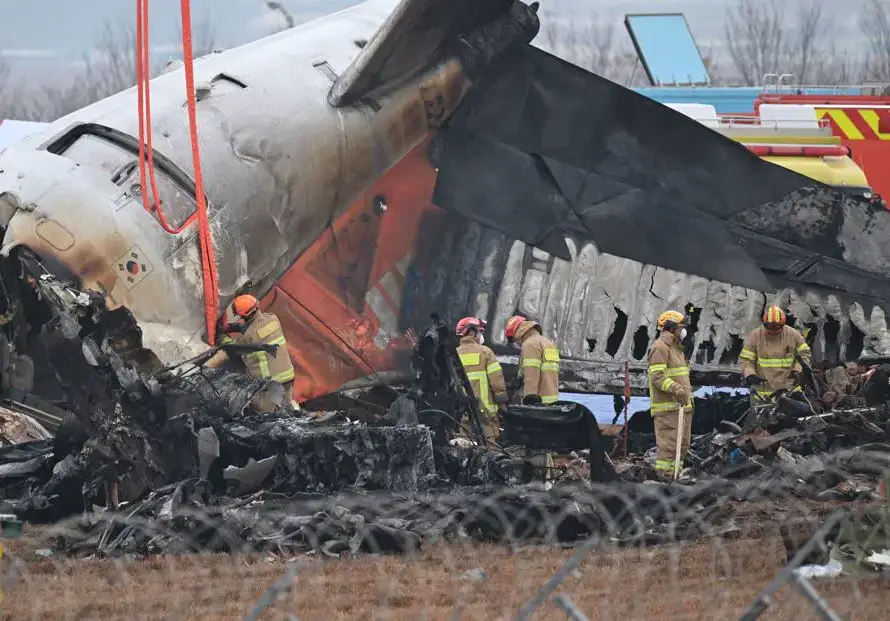A Jeju Air flight from Seoul on Monday was forced to return after encountering a landing gear problem, the airline said, a day after South Korea’s most deadly plane crash.
The Boeing 737-800 involved in the latest incident was the same model as the Jeju Airplane that crashed on Sunday killing 179 people after coming down without its landing gear engaged.
Jeju Air Flight 7C101, which departed Seoul’s Gimpo International Airport for Jeju island “at around 6:37 am, returned to Gimpo at 7:25 am” after a landing gear issue was detected shortly after takeoff, the South Korean airline said.
“Shortly after takeoff, a signal indicating a landing gear issue was detected on the aircraft’s monitoring system,” Song Kyung-hoon, head of the management support office at Jeju Air, told a news conference.
“At 6:57 am, the captain communicated with ground control, and after taking additional measures, the landing gear returned to normal operation. However, the decision was made to return to the airport for a thorough inspection of the aircraft.”
Local media reported that 21 passengers chose not to board an alternate flight to Jeju, citing concerns over safety and other reasons.
Jeju Air’s 41 plane fleet includes 39 Boeing 737-800 aircraft.
Seoul said on Monday it would conduct a special inspection of all 101 Boeing 737-800 planes in operation in the country, with US investigators, possibly including from plane manufacturer Boeing, joining the probe into the crash.
“We are reviewing plans to conduct a special inspection on B737-800 aircraft,” said Joo Jong-wan, head of the aviation policy bureau at the South Korean transport ministry.
Joo added that the government plans to “implement rigorous aviation safety inspections in response to the (landing gear) incidents”.
In Sunday’s crash at Muan, the Boeing 737-800 carrying 181 people from Thailand to South Korea made a mayday call and belly-landed before crashing into a barrier and bursting into flames.
Everyone on board Jeju Air Flight 2216 was killed, save two flight attendants pulled from the wreckage.
ENCORE, le vol sud-coréen de Jeju Air souffre d’un problème d’atterrissage
Un vol de Jeju Air en provenance de Séoul a été contraint lundi de rentrer après avoir rencontré un problème de train d’atterrissage, a annoncé la compagnie aérienne, un jour après l’accident d’avion le plus meurtrier en Corée du Sud.
Le Boeing 737-800 impliqué dans le dernier incident était le même modèle que l’avion de Jeju qui s’est écrasé dimanche, tuant 179 personnes après être descendu sans que son train d’atterrissage soit engagé.
Le vol 7C101 de Jeju Air, qui a décollé de l’aéroport international de Gimpo de Séoul à destination de l’île de Jeju « vers 6h37, est revenu à Gimpo à 7h25 » après qu’un problème de train d’atterrissage ait été détecté peu après le décollage, a indiqué la compagnie aérienne sud-coréenne.
“Peu de temps après le décollage, un signal indiquant un problème de train d’atterrissage a été détecté sur le système de surveillance de l’avion”, a déclaré Song Kyung-hoon, chef du bureau de soutien à la gestion de Jeju Air, lors d’une conférence de presse.
« A 6h57, le commandant de bord a communiqué avec le contrôle au sol, et après avoir pris des mesures complémentaires, le train d’atterrissage est revenu en fonctionnement normal. Cependant, la décision a été prise de retourner à l’aéroport pour une inspection approfondie de l’avion. »
Les médias locaux ont rapporté que 21 passagers avaient choisi de ne pas embarquer sur un autre vol à destination de Jeju, invoquant des préoccupations concernant la sécurité et d’autres raisons.
La flotte de 41 avions de Jeju Air comprend 39 Boeing 737-800.
Séoul a annoncé lundi qu’elle procéderait à une inspection spéciale des 101 Boeing 737-800 en opération dans le pays, avec la participation d’enquêteurs américains, notamment du constructeur aéronautique Boeing, qui se joindraient à l’enquête sur l’accident.
“Nous examinons les plans visant à mener une inspection spéciale sur les avions B737-800”, a déclaré Joo Jong-wan, chef du bureau de la politique aérienne au ministère sud-coréen des Transports.
Joo a ajouté que le gouvernement envisage de « mettre en œuvre des inspections rigoureuses de la sécurité aérienne en réponse aux incidents (de trains d’atterrissage) ».
Lors du crash de dimanche à Muan, le Boeing 737-800 transportant 181 personnes de Thaïlande vers la Corée du Sud a lancé un appel de secours et s’est posé sur le ventre avant de s’écraser contre une barrière et de prendre feu.
Toutes les personnes à bord du vol Jeju Air 2216 ont été tuées, à l’exception de deux agents de bord retirés de l’épave.


